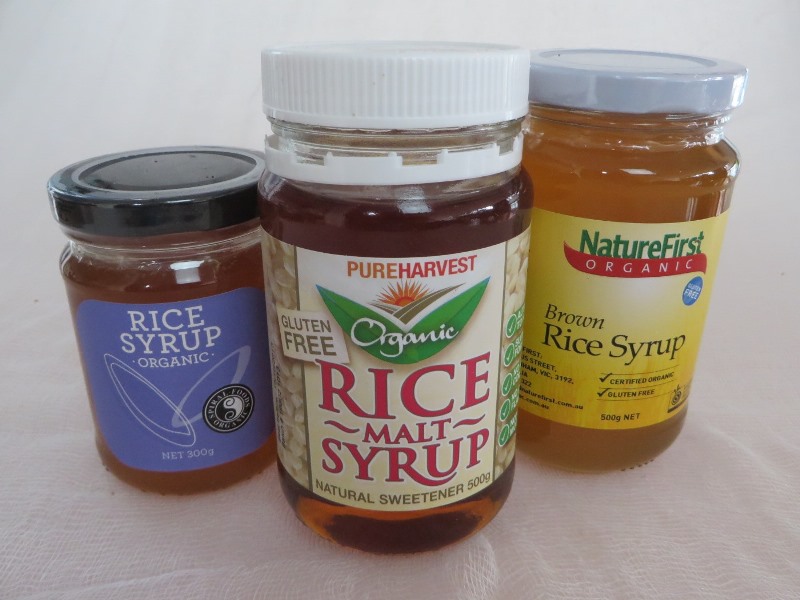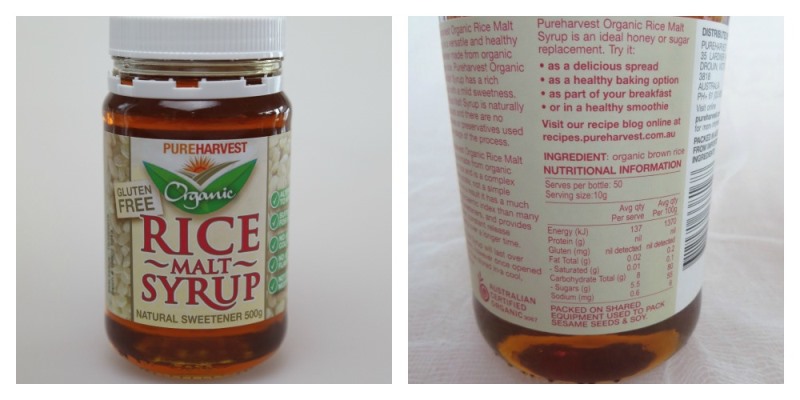Product Snapshot: Rice Malt Syrup

Rice malt syrup, or brown rice syrup, keeps popping up on my radar. It’s the trendy sweetener of the times and is used, in place of sugar, in everything from raw bliss balls, or alternative versions of dessert. It’s also sought after as a vegan substitute for honey. But is it a ‘healthier’ form of sugar? Should you swap to it instead of using sugar?
So what is rice malt syrup?
Rice malt syrup is a sweetener that’s beloved by the no-fructose movement and used in generous quantities in almost all of their sweet recipes. Although it has become trendy it’s been a traditional sweetener in China and Japan for a long time*. It has little fructose but it’s still a form of sugar as are agave and maple syrups, and as such, it must be counted on diets.
How is rice malt syrup made?
Rice malt syrup is produced commercially by using enzymes to break down the starches from rice or brown rice. This produces a liquid mix of sugars and short chains of sugars which is then filtered and the excess water cooked off.
On the label, it says that the syrup is made from organic brown rice which must make buyers feel good. But by the time it’s been treated and boiled, there’s not a great deal of nutrition left in the syrup. What is left is a thick, sugary syrup, which really doesn’t resemble brown rice at all.

Beer normally relies on malted barley as its source of fermentable sugars but rice malt syrup is also used as it has very little inherent flavour and produces a beer that has a paler colour and a lighter, crisper flavour. Most of the commercial American pilsners such as Budweiser use a significant quantity of rice syrup to their brewing.
Remember, that whether rice or barley, the sugars - fructose, glucose, sucrose and maltose - are almost 100 per cent fermented by yeast. Consumers are not drinking “rice syrup” when they drink beer.
How does rice malt syrup taste?
Rice malt syrup looks promising, like a jar of golden honey, but has none of honey’s attractive aroma or natural sweetness. You’d feel cheated if you spread it on a slice of toast and expected the same satisfaction as with honey.
Disappointingly, I find it has a one-dimensional flavour – yes there’s sweetness and stickiness but it’s flat and short-lived. Gone in a second with no lingering after-taste. Plus it tastes about half as sweet as honey.
How does it compare to sugar?
Rice malt syrup is a mixture of simple glucose, maltose (two glucose units joined together) and maltotriose (three glucose units joined together). There is virtually no fructose present. Some websites used to claim that rice malt syrup had a GI of 25 but this is not the case.
It has an extremely high Glycaemic Index (GI) of 98, according to the Sydney Uni Testing Lab. This is almost the same as pure glucose (the maximum on the GI standard) which has a GI of 100.
Note: You may read on other websites, including those of some manufacturers like Mitoku that it “provides a slow but prolonged source of energy”. It’s hard to see how this can be the case with a GI of 98.
This high GI is a negative in my opinion. It means that rice malt syrup passes quickly through the stomach into the small intestine where our digestive enzymes break it down to single glucose units, resulting in a rapid rise in blood glucose levels.
In contrast, ordinary sugar (white, brown or raw) is sucrose which is a disaccharide or double-sugar consisting of one molecule of glucose joined to one molecule of fructose. Sugar has a moderate GI of 65. It has to be split into its component sugars which are then absorbed. It’s not wonderful but it has a much lower GI.
Nutrition stats
Here’s how the most popular supermarket brand of rice malt syrup (Pure Harvest) stacks up.
Spoon for spoon, it’s very similar to honey. See the table for comparison.
One tablespoon (10 g) supplies 137 kJ, 8 g carbs (of which 5.5 are sugars), no protein, no fat and no fibre. There’s little of any other vitamin or mineral – there may possibly be tiny amounts of minerals like calcium and potassium but not as much as you’d get from dairy or fruit so don’t start using it for nutrition reasons.
|
Syrup |
kJ | Carbs | Sugars | Fructose | Pot | Cal | Mag | Sodium |
| Brown rice syrup, 100 g | 1370 | 80g | 55g | Low | na | na | na | 6mg |
| Honey, 100 g | 1400 | 82g | 82g | 38g | na | na | na | 15m |
The figures in this table were drawn from the labels of Pure Harvest Rice Malt Syrup and Beechworth Honey with the honey fructose figure being calculated by me, as just short of half the sugars present.
Rice syrup and arsenic
Another negative is that certain syrups may have been contaminated with arsenic. In Australia, food laws limit arsenic levels for cereals such as rice. This especially applies to brown rice as it retains more arsenic in its outer hull than white. Pure Harvest advises that their product is well below the limit of detection for arsenic which is good to hear.
My verdict?
Rice malt syrup, even if made from organic rice, is still a sugar. It contains almost no fibre and is almost pure sugar (maltose and maltotriose). On the plus side it contains no fructose or sucrose, and must consequently be regarded as safer than high fructose corn syrup or ordinary sugar. It is not suitable for diabetics and care needs to be taken to avoid excessive consumption.
No, it’s not healthy. Like other syrups, it is basically just empty kilojoules/Calories, that will spike your blood glucose and add to a weight problem if taken in excess. It should be used in place of, not in addition to, ordinary sugar. Like other syrups, use it sparingly – just enough to sweeten a mug of hot milk or stewed fruit.
* P 187 The Ultimate Guide to Sugars and Sweeteners Alan Barclay, Claudia Shwide-Slavin and Philippa Sandall



